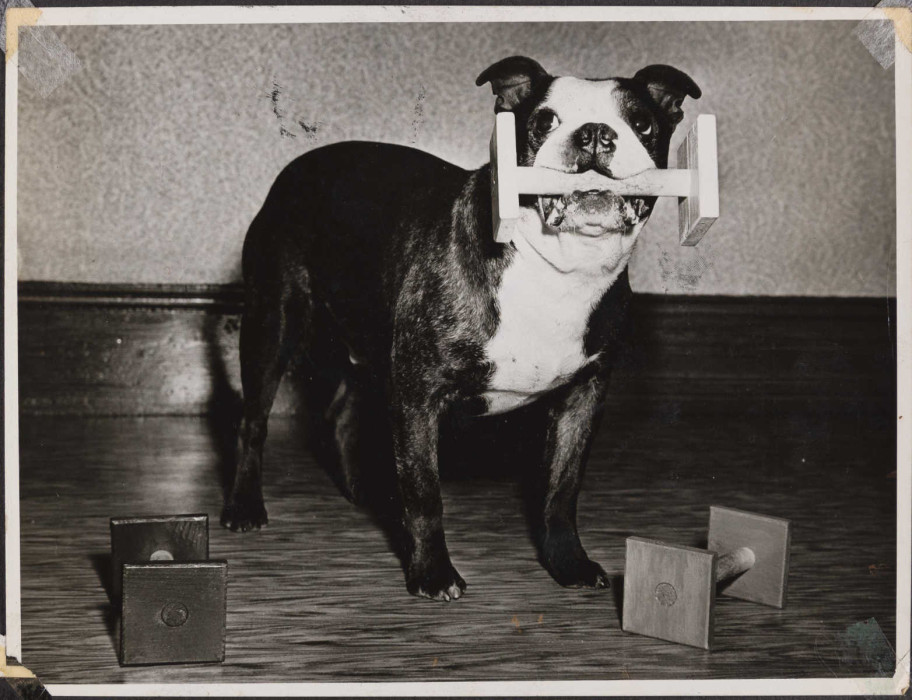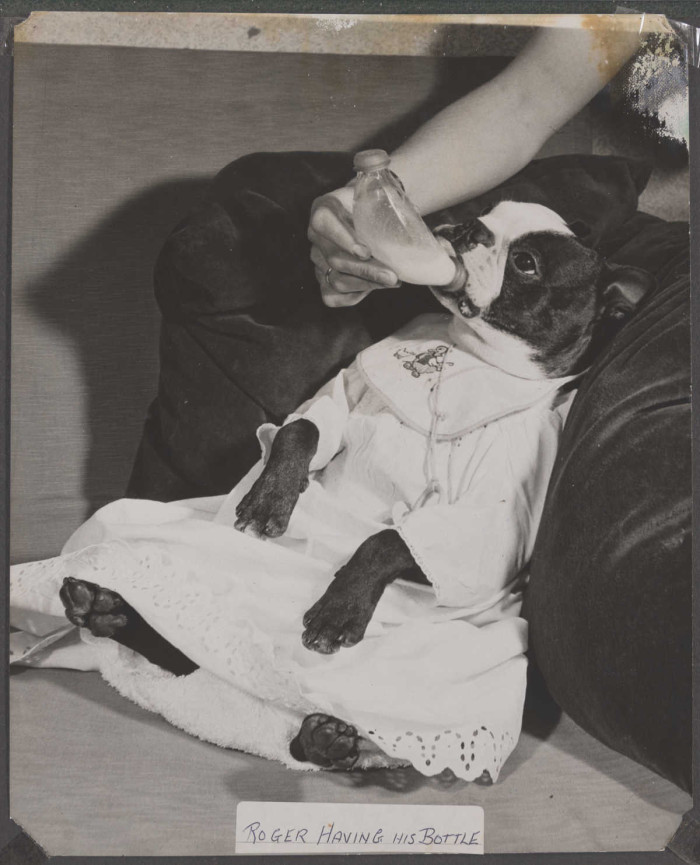Our story starts in 1946, when young widow Doris Whitehorn (1914-2019), bought a Boston Terrier puppy to help console her after her husband died of TB. Doris and her husband had only just moved into their first home together after his return home from war service in the Royal Army Medical Corps, where he had contracted the disease. She was a committed animal lover, having trained pet birds to do tricks as a schoolgirl, and a previous beloved pet dog had attended her wartime wedding. But Roger the Boston Terrier was not only a comfort to her in her grief, he soon proved to be a dog of quite remarkable talent. In fact, if he was around today we suspect he would have won certain TV talent shows hands down!

Doris taught him his first simple tricks, to sit and beg, when he was just 10 weeks old; by the age of 14 weeks he had mastered “Sit”, and could also be trusted to wait and not touch food until he was told it was “paid for”. At the same age he could walk six steps on his hind legs, and knew the meaning of “Find it” when a biscuit was hidden. By the age of four months he walked well on a lead and was almost completely house trained. At a year old, he could sing (almost literally) for his supper, and at 18 months he could say “I want some” quite distinctly. Doris noted down at the time, ‘This has to be heard to be believed’. If only we had a recording! But we do have a wonderful photograph album of this clever dog, and Doris’s record of their relationship (catalogue reference D/EX2966).

As a young puppy Roger was nervous of children and strangers. That certainly changed, though he did try to bite the judge at his first dog show! After two and a half years’ training, he became the lovable star of fetes, children’s parties and old people’s functions. Not only could he perform many standard tricks such as dancing on his hind legs, shaking hands, etc., he could even vocalise sounds like human words, and was sometimes billed as Roger the Talking Dog. He could balance an egg in an egg-cup on his head, and could repeat this trick with a full cup, saucer and plate. He could box, dance ballet and play football. Even though dogs are normally thought to be colourblind, Roger could pick out different coloured items by name. He once got so excited by the football he bit Doris, although normally his manners were perfect. He was a lifelong learner too, constantly adding new tricks to his repertoire.

He made his performing debut in January 1950, doing an act entitled ‘A Day in the Life of an “Almost Human” Dog’ at an Old Age Pensioners’ party at the Methodist Church Hall in Tilehurst. The Reading Standard reported on this act, culminating in the following:
“Without a sound he permitted Mrs Whitehorn to dress him in baby’s night-wear, complete from napkin [nappy] to night-cap, and then waited patiently for his mistress to prepare his supper. When all was ready, Roger started to sing. For fully a minute he filled the room with high-pitched whining up and down the scale, finishing it with a gruff yet audible “I want some, mother, please”. And so to bed. Cradled in Mrs Whitehorn’s arms, Roger greedily sucked milk from a baby’s bottle, falling asleep with a gentle snore as he drained it.”


Many of his tricks were performed in appropriate outfits. His cute poses included dressing up as a sunbathing beauty, a cowboy holding a cigarette in his mouth, and Sir Winston Churchill with a cigar. The cigar meant audiences recognized his take on Churchill immediately.

In 1952 Roger entertained royalty when Doris was invited to bring him to perform at the third birthday party of little Princess Margareta of Romania at Bramshill Park, just over the border in Hampshire. The guests included 3 year old Prince Charles [King Charles III] and his toddler sister Princess Anne [the Princess Royal], whose father Prince Philip was Margareta’s godfather. The British royal children were allowed exclusive time to play with Roger off duty after his performance. Seeing Charles with a biscuit, Roger spontaneously performed his trick of saying “I want some”, and was duly rewarded with the little prince’s biscuit. Many years later, Doris met the future King again when being given an award, and he told her remembered the ‘little dog’’s amazing performance.

The next performance was for less privileged children at Wallingford Children’s Home. Doris worked as a typist for Berkshire County Council’s Children’s Department, and Roger’s performances were always for charity, the proceeds usually going to the RSPCA. He also appeared on television, and at the time of his death it was intended to make a special TV film showcasing him. He missed out on other TV opportunities due to a train strike and not being allowed to fly as a flat-faced breed. He was often featured in local newspapers.

At home, Roger was just a beloved pet – although arguably an unusually well behaved talented one! He loved biscuits, cuddles and walks, but was not a fan of the rain. He loved playing in the recreation ground in Tilehurst with his ball. He enjoyed chewing marrow bones and knuckle bones, and was also a fruit fan, loving oranges as a special treat. His daily diet as an adult dog included a bowl of milk tea for breakfast, a main meal at midday of meat, liver or fish, with biscuits, vegetables and gravy, and a biscuit and milky drink at bed time. He weighed 26 ½ pounds.

He died aged 10 in June 1956. Doris never lost her love for animals, although none of her later dogs or other pets were like Roger. In 1957 she remarried, having found love with Ronald Gash, a work colleague who had helped with some of Roger’s later performances. They adopted a daughter, and set up the Tilehurst Animal and Bird Sanctuary at their Norcot Road home. Many Reading and West Berkshire families may recall getting their childhood pet dogs and cats from her, and she also worked rehabilitating injured wildlife. Perhaps that is Roger’s greatest legacy?
Do you remember seeing Roger perform? Why not share your stories on our social media channels or Contact Us.
